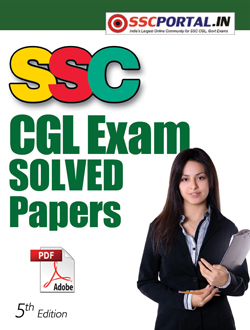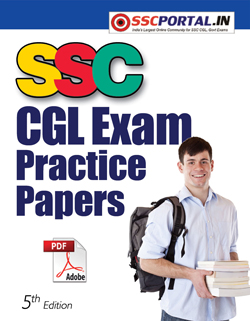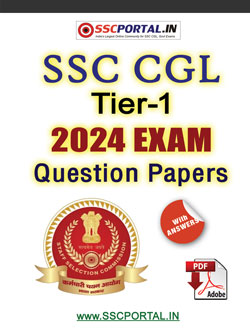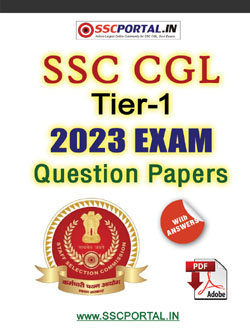NEW! SSC CGL PDF NOTES
SSC CGL MCQ : History
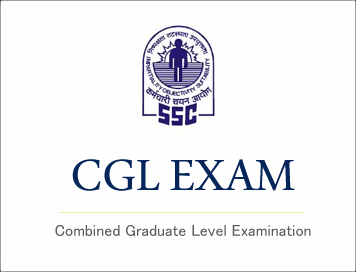
SSC CGL MCQ : History
1. Which was the first metal used by man?
(a) Copper
(b) Silver
(c) Bronze
(d) Brass
2. With which of the following periods do we associate the ‘microlith’ implements?
(a) Palaeolithic
(b) Mesolithic
(c) Neolithic
(d) Chalcolithic
3. With which period do we associate the ‘megaliths’?
(a) Neolithic
(b) Chalcolithic
(c) Mesolithic
(d) Pleistocene
4. When the first metal tool came into being it was used for?
(a) pot-making
(b) house-building
(c) clearing jungles
(d) making wheels
5. The Stone Age people had the first domestic:
(a) asses
(b) dogs
(c) horses
(d) sheep
6. Nomad man started settling in:
(a) Palaeolithic Age
(b) Mesolithic Age
(c) Neolithic Age
(d) None of these
7. The greatest invention of man in Palaeolithic Age was:
(a) fire
(b) potter’s wheel
(c) metal implements
(d) spinning of cloth
8. Indus Valley Civilization is also known as Harappan culture because:
(a) the site of Harappa is six times larger than Mohenjodaro site
(b) the Indus Valley Civilization is considered the elementary /initial stage of Vedic culture and Harappa is believed to be the same as Harappa mentioned in the Vedas
(c) Harappa was the first site to be excavated in the Indus Valley
(d) the most important evidence of the achievements of this civilization have been excavated from Harappa
9. The Indus Valley Civilization flourished during:
(a) 5000-3500 B.C
(b) 3000-1500 B.C
(c) 2500-1750 B.C
(d) 1500-500 B.C
10. Which of the following statements regarding the Indus Valley Civilization is not true?
(a) The excavations at Harappa are attributed to Daya Ram Sahni
(b) The Assembly Hall was discovered at Mohenjodaro
(c) The open courtyard was the basic feature of house planning
(d) The Indus Valley people were not acquainted with the art of spinning and weaving
11. Match the following:
Ancient site Archeological finding
A. Lothal 1.Ploughed field
B. Kalibangan 2. Dockyard
C. Dholavira 3. Terracotta replica of a plough
D. Banwali 4. An inscription comprising ten
large sized signs of the Harappan script
Codes: A B C D
(a) 1 2 3 4
(b) 2 1 4 3
(c) 1 2 4 3
(d) 2 1 3 4
12. Out of the following remains excavated in Indus Valley, which one indicates the commercial and economic development?
(a) Pottery
(b) Seals
(c) Boats
(d) Houses
(E-Book) SSC CGL (Tier-1) Exam 2020 Solved Question Papers PDF Download
13. The Indus Valley Civilisation was discovered in :
(a) 1902
(b) 1921
(c) 1922
(d) 1932
14. Which of the following is/are Indus Valley site/s in India?
1. Rangpur
2. Banwali
3. Sutkagendor
4. Alamgirpur
(a) 1 and 4
(b) 1, 2 and 3
(c) 1,2 and 4
(d) 1, 2, 3 and 4
15. Match the following:
A. Practice of fire cult 1. Lothal
B. Lower town fortified 2. Kalibangan
C. Great Bath 3. Mohenjodaro
D. Granary 4. Harappa
E. Shipbuilding 5. Surkotada
Codes: A B C D E
(a) 1 2 3 4 5
(b) 5 4 3 2 1
(c) 2 5 3 4 1
(d) 5 3 4 2 1
16. Use of plough has been evidenced at:
(a) Kalibangan
(b) Lothal
(c) Harappa
(d) Banwali
17. Which of the following crops were grown by the people of the Indus Valley Civilisation?
1. Wheat
2. Barley
3. Cotton
4.Peas
(a) 1,2 and 4
(b) 1, 2, 3 and 4
(c) 1 and 2
(d) 1, 2 and 3
18. Which of the following items and the place of their discovery is wrongly matched?
(1) Statuette of a bearded man – Mohenjodaro
(2) Rice husks – Lothal
(3) Fire pits and altars – Harappa
(4) Bead-makers shop – Chanhudaro
(5) Fossil remains of a horse – Surkotda
(a) 3
(b) 2
(c) 1
(d) 1 and 5
19. Match the following:
Harappan site State
A. Kalibangan 1. Punjab
B. Mohenjodaro 2. Rajasthan
C. Rangpur 3. Gujarat
D. Surkotda 4. Sind
Codes: A B C D
(a) 2 1 3 4
(b) 2 4 1 3
(c) 3 4 2 1
(d) 4 2 1 3
20. Which one of the following archaeologists initially discovered the Mohenjodaro site of the Indus Valley Civilization?
(a) Sir John Marshall
(b) Rakhal Das Banerji
(c) Daya Ram Sahni
(d) Sir Martimer Wheeler
21. The main characteristic of the Indus Valley Civilization was:
(a) town planning
(b) drainage system
(c) well laid out roads
(d) pucca houses
22. The main occupation of the people of the Indus Valley civilization was:
(a) agriculture
(b) cattle rearing
(c) hunting
(d) trade
23. The Indus Valley people knew the use of :
(a) gold, silver, copper, bronze but not iron
(b) copper, iron, gold but not bronze
(c) silver, lead, iron but not gold
(d) gold, tin, bronze but not copper
24. Knowledge about the existence of which of the following animals is doubtful in the Indus Valley Civilization?
(a) Dog
(b) Cat
(c) Bull
(d) Horse
25. The Indus Valley people had trade relations with :
(a) Egypt
(b) Greece
(c) Ceylon
(d) Mesopotamia
26. At which Harappan site have traces of a horse been found?
(a) Kalibangan
(b) Lothal
(c) Surkotda
(d) Suktagendor
27. Mohenjodaro is also known as:
(a) mound of the Great
(b) mound of the Survivors
(c) mound of the Living
(d) mound of the Dead
28. The script of Indus Valley Civilization was/is :
(a) Persian
(b) Dravidian
(c) Sanskrit
(d) Undeciphered
29. The Indus Valley Civilization belongs to the:
(a) neolithic age
(b) palaeolithic age
(c) chalcolithic age
(d) mesolithic age
30. There are similarities between the seals found at Mohenjodaro and :
(a) Egypt
(b) China
(c) Sumeria
(d) Afghanistan
31. The Harappan seals, containing the picture of Proto-Shiva, do not depict:
(a) Elephant and tiger
(b) Bull and cow
(c) Rhinoceros
(d) Buffalo and deer
32. From which one of the following sites, was the famous Bull-seal of Indus Valley found ?
(a) Harappa
(b) Chanhudaro
(c) Lothal
(d) Mohenjodaro


